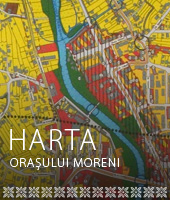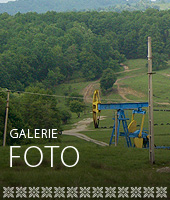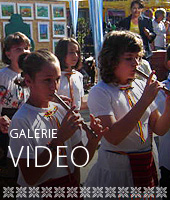Events Calendar
vizite
The climate has an impact on all components of geographical cover: vegetation, soils, water, the relief and is in turn influenced by them. By its geographical position, between the high plain and Subcarpathian, with large passage of Cricovul river to the mountainous area that creates a breathtaking view on clear days (when Bucegii towers majestically between blocks), Moreni is located in a temperate continental climate.
The average temperature in July Moreni is between 21 - 23° C, maximum and can reach 38 - 39oC in the warmest years.
The average January temperature is 1 - 3oC, lows could fall on certain days of winters 'cold' to - 25oC. The relief area allows average temperatures in the southern part of the village to be higher than those in southern Piedmont, and temperatures fact proved in northern localities that are higher than those of Cricovul sources. Differences between the extreme points of the village not exceed 1 - 3oC (in extreme cases), under the current zoning altitude and influence plays an important role. The average annual temperature in Moreni was set at 10oC.
For agricultural and for a range of economic activities, a great importance have the phenomena of high occurrence and disappearance of frost.
Following the date of occurrence of the first frost days is found that may occur between October 10 to 20, the frost can be reported starting on 15 September and the period when it recorded the last days of frost is April 10 to 18, rarely last decade of April.
The total number of sunny days is an average of 110-130, approximately equal to the days of clouds lately recorded an increase in the number of days with cloudy sky.
Rainfall is most influenced by topography and vegetation structure. The massive nearby wooded hills, permit normally 700 mm values. Moreni comparable Ialomita Valley, where the same value is far north due to lack of forests.
The wettest month for this area is June when it reaches the maximum (155 mm.), As values fall until November (approx. 80 mm.); Further ascending. Important differences can be seen in the daily regimen of rains. The highest amount of rainfall is recorded between 13 - 15 hours, when the rains are less lasting and highest intensity, whereas in the early morning rains have longer duration and less intensity. Heavy rains, rare but still present, are very dangerous by the action of soil erosion or flood production (1970 - 1972 Cricovul overflowed). In much of the winter precipitation falls as snow, however. The snow falls on average 20 - 30 days, and the layer formed on the surface of the soil is maintained for 40 - 80 days, rarely exceeding 50 cm. (in from 1953 to 1954 reached snow was 150-180 cm).
The regime of winds depends of direction, speed and frequency of major air masses and the conditions of the relief. The main directions of the wind are the N, NW, rarely S, with average speeds between 1-3 m /s (rarely during summer storms), the largest being in April, the lowest in June, more than half of the year by setting up a calm time. The northern wind winds are the most popular winter and summer wind Băltăreţul.
The microclimate is a change of climate which is due, in particular the local landscape, orientation and opening of valleys. The slopes exposed to the south is characterized by a greater amount of heat and light and a smaller amount of moisture (Pleaşa hills, Cristian and Tuicani). The lower slopes are characterized by a greater amount of heat in summer, especially during the day and an amount of less heat in winter and during the night, following on pressure cold air in the valley Cricovul (see the difference between the center and "Staging Great "spring by flowering apricot evident with 2-3 days earlier). Eastern slopes of the exhibition is characterized by a greater amount of heat and light, especially in the morning hours. Although the western slopes and the eastern considered, however, are distinguished by extra moisture. However, on sunny days, the Western slopes are characterized by a touch of warmth to those Easterners, because here sunstroke afternoon is already a hot environment, while in the morning on the eastern consume some heat by evaporation . The nights and winters are characterized by low temperatures due to radiation leakage land and cold air from the heights.










